Building Healthy Communities for Active Aging Awards 2007
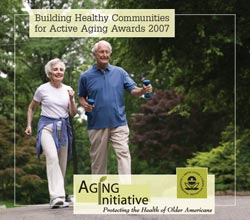 The principal goal of the Building Healthy Communities for Active Aging Award program is to raise awareness across the nation about healthy synergies that can be achieved when communities combine and implement the principles of smart growth with the concepts of active aging. Awards are presented to communities demonstrating the best and most inclusive overall implementation of smart growth and active aging at the neighborhood, municipal, tribal, county and regional levels. Applicants are evaluated based on the overall effectiveness of their programs, level of community involvement and outreach, use of innovative approaches, and overall environmental and health benefits of the project.
The principal goal of the Building Healthy Communities for Active Aging Award program is to raise awareness across the nation about healthy synergies that can be achieved when communities combine and implement the principles of smart growth with the concepts of active aging. Awards are presented to communities demonstrating the best and most inclusive overall implementation of smart growth and active aging at the neighborhood, municipal, tribal, county and regional levels. Applicants are evaluated based on the overall effectiveness of their programs, level of community involvement and outreach, use of innovative approaches, and overall environmental and health benefits of the project.
- About the Award
- Achievement Award Winners
- Commitment Award Winners
- Brazos Valley Council of Governments, Texas
- Carver County Public Health Division and Carver County Health Partnership, Minnesota
- City of Rogers, Arkansas
- Queen Anne's County Housing Authority, Maryland
- Town of Scarborough, Maine
- What is Smart Growth?
- What is Active Aging?
- Connecting Smart Growth and Active Aging
- Announcing the 2008 Awards for Building Healthy Communities for Active Aging
- Self Management Assessment and Resource Tool
- Acknowledgements
- Printable version of the Building Healthy Communities for Active Aging Awards 2007 (PDF). (16 pp, 519K About PDF).

Individuals and the community benefit when people of all ages engage in an active lifestyle.
About the Award
The Building Healthy Communities for Active Aging Awards show the nation the great results communities can achieve by combining smart growth with the concepts of active aging.
Awards go to communities with the best and most inclusive use of smart growth and active aging. Applicants are evaluated based on:
- overall effectiveness of the programs
- level of community involvement and outreach
- use of innovative approaches
- overall environmental health benefits of the project
There are two types of awards.
- Achievement Award winners demonstrate:
- excellence in building healthy communities for active aging
- their programs and policies improve the health and well-being of the community and its citizens
- excellence in building healthy communities for active aging
- Commitment Awards recognize communities planning for, and beginning to use, smart growth and active aging.
Achievement Award winners:
Commitment Award winners:
- Brazos Valley Council of Governments, Texas

- Carver County Public Health Division and Carver County Health Partnership, Minnesota

- City of Rogers, Arkansas

- Queen Anne’s County Housing Authority, Maryland

- Town of Scarborough, Maine

Achievement Award Winner

Accessible, welcoming facilities encourage physical activity among older adults.
Atlanta Regional Commission, Georgia
“Local leadership has emerged in many communities to develop new policies, start new programs and make significant change in the lives of older adults."
The Atlanta Regional Commission (ARC), which serves 10 counties and 66 cities in the Atlanta, Ga., metropolitan area, has a history of promoting smart growth and active aging. In 2002, ARC launched Aging Atlanta, a 50 organization partnership focused on meeting the needs of the region's growing older adult population. Aging Atlanta's pilot projects laid the foundation for the Lifelong Communities Initiative. The Initiative works with local governments to create housing and transportation options that enable older adults to "age in place." To improve housing options, ARC facilitated zoning policy changes and the development of 30 senior housing developments located close to services and connected to existing neighborhoods. With more than 90 percent of Atlanta's older adults relying on automobiles for transportation, ARC has taken steps to decrease auto dependency by promoting ride sharing through its six voucher programs and working to improve bus stops and routes. These efforts increase quality of life and offer environmental benefits.
To encourage healthy lifestyles, ARC partners converted traditional senior centers to wellness centers, emphasizing physical activity and social interaction. Currently, 46 of these centers offer programs for the 400,000 older adults in the metro area, and approximately 1,000 individuals have joined walking clubs. Through community involvement, ARC has incorporated older adults' needs into parks, trails and pedestrian paths. Working with city and county staff, ARC is integrating age-appropriate features into local sidewalk audits and plans.
Contact:
Cathie Berger (cberger@atlantaregional.com)
Division Chief,
Aging Services
Atlanta Regional Commission
(404) 463-3235
Achievement Award Winner

Group walks around Kirkland's neighborhoods promote exercise and minimize social isolation for older adults.
City of Kirkland, Washington
“Here I can walk to the lake, the senior center, the stores or use public transportation. Do I use the pedestrian flags? You bet. I love them."
The city of Kirkland, Wash., strives to make its physical activities more accessible for its 19,000 older residents by organizing exercise opportunities and improving infrastructure.
The city offers more than 50 physical activity programs specifically designed for older adults. The Kirkland Steppers Walk Program, which is free for adults over age 50, organizes group walks through downtown twice a week during the summer.
Over the next six years, the city of Kirkland will invest $6 million to improve sidewalk connections between commercial and residential developments to make the city more walkable. In addition, Kirkland is the first city in the state of Washington to adopt a Complete Streets Ordinance to design streets for the needs of walkers, bicyclists and drivers. It has adopted two innovative programs: the "PedFlag" Program, which has placed flags at 63 crosswalks to remind drivers to yield to pedestrians, and the Flashing Crosswalk Program, which has incorporated flashing lights into the pavement of 30 crosswalks. Both programs promote a safe pedestrian environment. By listening to the good counsel and recommendations from the Active Living Task Force and the Kirkland Senior Council, the city of Kirkland has and will continue to enhance the quality of life for its older residents.
Contact:
Carrie S. Hite (chite@ci.kirkland.wa.us)
Deputy Director Parks & Community Services
City of Kirkland
(425) 587-3320
Commitment Award Winner
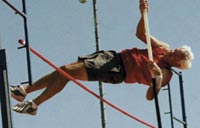
The Brazos Valley Senior Games highlight the benefits of active aging.
Brazos Valley Council of Governments, Texas
“We are especially proud of the success of the implementation of our Evidence-Based Program, our transportation system, and the growing number of programs and opportunities for Brazos Valley residents to become more active."
The Brazos Valley Council of Governments (BVCOG) is a regional planning association encompassing seven counties in Texas' Brazos Valley. In 2007, after consulting citizens and stakeholders, the BVCOG created the Brazos Valley Building Healthy Communities Coalition to link smart growth and active aging principles in both rural and urban areas of the region. As part of this effort, the Wolf Pen Creek corridor was designated as a design district. The Wolf Pen Creek master plan was developed to ensure coordinated development that preserves the ecological integrity and creates new mixed-use developments including residential, office and recreational uses.
The BVCOG's Agency on Aging created a Senior Transportation Program to provide door-to-door rides to senior centers, retail stores and health care facilities for older residents. The Senior Transportation Program is staffed primarily by volunteers. Ridership has increased dramatically, and the program currently serves more than 1,000 individuals each month. Increasing accessibility to key amenities and to walkable parks and town centers creates a more livable community for older residents.
Contact:
Tom Wilkinson (twilkinson@bvcog.org)
Executive Director
Brazos Valley Council of Governments
(979) 595-2800
Commitment Award Winner

Members of the city of Victoria Senior Commission and other community members conduct a walking audit as part of a Walkability Workshop.
Carver County Public Health Division and Carver County Health Partnership, Minnesota
“[Our agency] has worked closely with Carver County and the Health Partnership in their cutting-edge work to develop and implement a county-wide initiative to prepare for an older population. Their efforts have provided outstanding results."
Foreseeing a dramatic increase in the aging population, the Carver County Health Partnership incorporated smart growth and active aging principles into a Master Plan on Aging. Elected officials, key stakeholders and residents served on a county-wide Senior Commission to develop the master plan. In response, the Carver County Board of Commissioners adopted a "Communities for a Lifetime" vision statement in 2006 and in 2007 created the Office of Aging, housing it in the county's Public Health Division.
The development of the "Communities for a Lifetime" approach demonstrates Carver County's commitment to addressing the needs of its 65-plus population—expected to quadruple to 20,820 by 2030. The approach lays the foundation for improving housing, transportation and physical activity options throughout the county.
Already this approach has supported housing efforts such as The Crossing, a mixed-use development that combines city offices and a public library with 68 senior housing units, and initiatives to create walkable communities to increase the physical activity levels of older adults. Two cities in Carver County have successfully completed Walkable Community Workshops, demonstrating progress in advancing active aging initiatives throughout the county.
Contact:
Katy Boone (kboone@co.carver.mn.us)
Office of Aging Planner
Carver County Public Health
(952) 361-1329
Commitment Award Winner

Regular sessions of low-impact activities, such as swimming, can increase quality of life for older adults.
City of Rogers, Arkansas
“When we first started going to the Wellness Center, I could barely walk with a cane… I don't use a cane anymore. I can walk, and I feel so much better than I did."
Located on a formerly blighted site in Rogers, Ark., the Adult Wellness Center (AWC) provides physical and social opportunities for adults from age 50 and older. Each month the center offers more than 30 age-appropriate physical activity classes and 50 mental and social activities. Each day between 750 and 1,000 older adults come to the center for organized group activities and to independently work out, walk, swim or play competitive recreational sports. With strong community support, the AWC provided educational and physical opportunities to more than 6,500 members in its first year. The facility was specifically designed for the city's aging population and provides a safe and enjoyable environment for older adults.
During the development phase of the AWC, a primary consideration was to locate it within walking distance of amenities. AWC is situated near a 32-unit low-income senior housing complex, hospital, library, grocery store and mall. The AWC neighborhood has become a walkable smart growth community. Future plans for the neighborhood include a 72-unit mixed-rate housing complex and a three-acre wellness garden with trails that will connect to the city trail system. By eliminating the barriers to physical and social activities, the AWC has enhanced the lives of many older citizens.
Contact:
Keri York Wilkinson (kwilkinson@rogersark.org)
Director
City of Rogers
Adult Wellness Center
(479) 631-3333
Commitment Award Winner
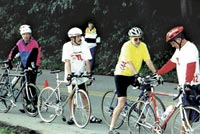
Connecting Terrapin Grove to the existing trail network has increased residents' ability to participate in self-directed physical activities, such as biking.
Queen Anne's County Housing Authority, Maryland
“We present a strong program of physical activities and social and educational events that assist seniors in remaining active in their communities."
The Queen Anne's County Housing Authority has created a model community for active aging through effective partnerships and strong community involvement. Terrapin Grove, located in Stevensville, Md., is a low- to moderate-income housing community for older adults, featuring a library, salon and country store. The adjacent Kent Island Senior Center offers an array of physical activities, including low-impact and chair aerobics, exercise classes, Tai Chi and yoga. All of the center's activities and classes were developed with community input. Through its partnerships with Chesapeake College, Terrapin Grove offers residents educational courses, museum tours and luncheon lectures. In collaboration with the Department of Parks and Recreation and Safe Harbor Church, a network of new walking trails was created that connects to the county trail system. Strong citizen involvement and agency partnerships helped to create an enriching environment for older residents in Queen Anne's County.
Contact:
Candice Darling (cdarling@qac.org)
Housing Program Administrator
Queen Anne's County Housing and Community Development
(410) 758-3977
Commitment Award Winner
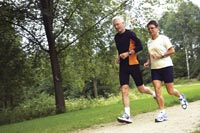
Trail improvements increase accessibility to outdoor physical activity.
Town of Scarborough, Maine
“The town's decision to support the construction of more than 200 units of affordable senior housing through flexible zoning and creative reuse of old schools provides an important resource for residents to age in place."
The Seniors Program Advisory Board collaborated with the town of Scarborough, Maine, to encourage responsible development and healthy living for all of its 18,900 residents. Through active community involvement, the town recently developed the Future Land Use Plan. The plan protects rural lands and open spaces and focuses development near existing resources. For example, a former school site was redeveloped into 60 affordable senior housing units in the town's community center. This excellent location provides older adults a greater sense of community and reduces reliance on motor vehicles.
Scarborough created the Senior Center Without Walls, which is a network of programs, services, and partnerships that specializes in addressing the needs of Scarborough's 6,000 residents who are 50 years of age and older. As part of this initiative, the town of Scarborough designed three senior-focused exercise programs and improved five miles of walking trails and three miles of sidewalks to increase opportunities for physical activity.
Contact:
Bill Reichl (comserv@ci.scarborough.me.us)
Scarborough
Community Services
Town of Scarborough
(207) 730-4150
For more information, please visit…
What is Smart Growth?
The built environment—places where we live, work and play—impacts people of all ages. Housing and transportation opportunities shape our environment and have longstanding consequences on our daily lives and the quality of our environment. Smart growth strives to minimize the impacts of our built environments both on human health and the natural environment by integrating environmental considerations into development patterns. Using smart growth, communities create attractive, walkable neighborhoods that give people of varying age, income level and physical ability a range of safe, affordable and convenient choices in where to live and how to get around.
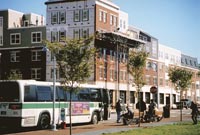
Smart growth development provides easy access to transit. Photo of Winooski, Vt. courtesy of Liisa Ecola.
Growing smart helps to reduce our ecological footprint and preserve natural resources and open space.
Smart Growth Principles
- Mix land uses
- Take advantage of compact building design
- Create a range of housing opportunities and choices
- Create walkable neighborhoods
- Foster distinctive, attractive communities with a strong sense of place
- Preserve open space, farmland, natural beauty and critical environmental areas
- Strengthen and direct development toward existing communities
- Provide a variety of transportation choices
- Make development decisions predictable, fair and cost effective
- Encourage community and stakeholder collaboration in development decisions
For more information on active aging, please visit these Websites…
Learning Network for Active Aging
www.LNactiveaging.org![]()
National Council on Aging's Center for Healthy Aging
www.healthyagingprograms.org ![]()
National Blueprint
www.agingblueprint.org![]()
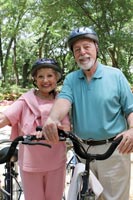
Physical activities, such as biking, can improve the quality of life for older adults.
What is Active Aging?
By 2030, the number of older persons in the United States is expected to double to more than 70 million. As our population ages, a growing number of us will be living with chronic conditions, placing increased pressure on our health care system. Only 20 percent of those over the age of 65 participate in regular activity, according to the Centers for Disease Control and Prevention. Many older adults live with at least one chronic condition. Research demonstrates that daily physical activity is vital for keeping fit and controlling chronic conditions. Creating a walkable community is one of the principles of smart growth that fosters active aging.
Active aging strives to promote strategies that engage older adults through a variety of structured and unstructured physical activities. Communities can promote active aging by implementing a diverse array of accessible physical-activity programs, increasing the accessibility of opportunities for self-directed physical activity for those 50 years of age or older and providing a safe, walkable environment.
Connecting Smart Growth and Active Aging

Smooth, flat surfaces promote walkability and prevent falls. Photo of Old Town Wichita, Kan., courtesy of Carlton Eley.
By adopting smart growth principles, communities can design places that increase mobility and improve quality of life for older adults. Neighborhoods that integrate a variety of uses, such as residential, commercial, and recreational features, enable residents, especially mature persons, to access key amenities without relying on their automobiles. Pedestrian-friendly, level walkways also increase access to these amenities and encourage older residents to walk to the doctor's office or local stores. By providing a range of housing opportunities, communities can enable residents to move within their neighborhood as their housing needs change. Such life-long residents help to establish a strong sense of place within a community. The benefits of building healthy communities for active aging are being realized in communities across the country. For example, the city of Saratoga Springs, N.Y., where 18 percent of the population is over 60 years of age, has created a mix of housing opportunities near the Saratoga Senior Center and medical facilities.
Announcing the 2008 Awards for Building Healthy Communities for Active Aging
For more information…
EPA Aging Initiative
www.epa.gov/aging
Please submit questions to
aging.info@epa.gov
EPA's Aging Initiative announces the 2nd annual Building Healthy Communities for Active Aging Awards program. The awards recognize outstanding community planning and strategies that support active aging. Communities will be recognized in two award categories—the Achievement Award and the Commitment Award. Winners will be announced in the spring of 2009. Applicants must be public sector entities in the United States and coordinate with their local Area Agency on Aging. Public sector entities include all levels of elected governments, from city councils to state legislatures and their subdivisions, such as planning departments and other executive branch divisions. Applications are due September 12, 2008. Applications, award guidelines and entry rules can be found at www.epa.gov/aging/bhc/awards.
Self Management Assessment and Resource Tool
The Self Management Assessment and Resource Tool includes 20 questions that can help a community assess its progress in integrating active aging concepts with smart growth principles. Each question focuses on a particular milestone, such as conducting a community assessment to determine the level of older adult participation in physical activity programs or formulating a plan to adopt smart growth planning. Communities are asked to select the category that best describes the progress of their active aging initiatives: not at all; partially completed; or fully completed. The tool also provides tips for getting started and links to potential resources for addressing each milestone. Communities can use the results from this self-test to identify opportunities to improve their active aging initiatives and smart growth planning efforts to promote a safe and healthy environment for older residents. For more information, please visit www.epa.gov/aging/bhc/bhcaa.pdf (PDF) (4 pp, 52K About PDF).
Acknowledgements
Thanks to the Steering Committee.
- Terry Bazzarre, PhD, Senior Program Officer, Robert Wood Johnson Foundation
- David M. Buchner, MD MPH, Chief, Physical Activity & Health Branch, Centers for Disease Control and Prevention
- Wojtek Chodzko-Zajko, PhD, Professor and Department Head, University of Illinois, Urbana-Champaign
- Judy Kruger, PhD, Epidemiologist, Centers for Disease Control and Prevention
- Catherine Liles, MPH, School of Rural Public Health, Texas A&M University
- Michael Marcus, MSW, Program Director for Aging, Weinberg Foundation
- John N. Migliaccio, PhD, Director of Research, MetLife Mature Market Institute
- Kevin Nelson, AICP, Senior Staff Member, Community & Environment Division, U.S. Environmental Protection Agency
- Marcia Ory, PhD, Professor, Texas A&M University
- Serena Sanker, MS, Senior Program Associate, National Council on Aging, Center for Healthy Aging
- Chris Spain, Director, Research, Planning & Special Projects, President's Council on Physical Fitness and Sports
- Kathy Sykes, MA, Senior Advisor, Aging Initiative, U.S. Environmental Protection Agency
- Brett Van Akkeren, MBA, Senior Staff Member, Community & Environment Division, U.S. Environmental Protection Agency
- Nancy Whitelaw, PhD, Director, Center for Healthy Aging and Senior Vice President, National Council on Aging
Thanks to the BHCAA Awards Supporters.
- AARP
- Active for Life (AFL)
- America Walks
- Administration on Aging (AoA)
- American Medical Association (AMA)
- American Public Health Association (APHA)
- Atlanta Regional Commission (ARC)
- American Society on Aging (ASA)
- Center for Civic Partnerships (CCP)
- Council of State and Territorial Epidemiologists (CSTE)
- Elder Care Advocacy of Florida
- Generations United (GU)
- Gerontological Society of America (GSA)
- Healthy Aging Research Network (HAN)
- International City/County Management Association (ICMA)
- International Council on Active Aging (ICAA)
- Local Government Commission (LGC)
- Milton H. Erickson Foundation, Inc.
- National Association of Area Agencies on Aging (n4a)
- National Blueprint Initiative
- National Council on Aging (NCOA)
- National Indian Council on Aging (NICOA)
- National Recreation and Park Association (NRPA)
![[logo] US EPA](https://webarchive.library.unt.edu/eot2008/20081017024044im_/http://www.epa.gov/epafiles/images/logo_epaseal.gif)